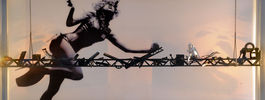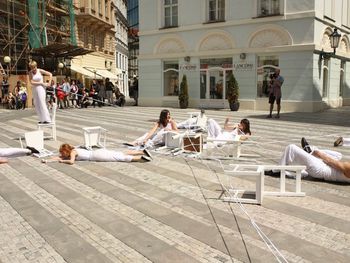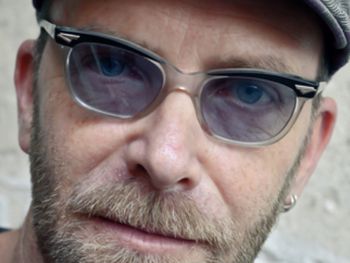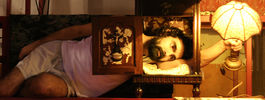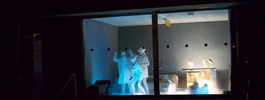Within the recent five years a new remarkable boom has been characteristic for the development of the Hungarian theatre. Pursuant to public competitions and various scholarships aiming at an encouragement of playwrights to new works, pursuant to a considerable attention and aid being devoted to theatre concerns, the Hungarian dramaturgy has gathered a new élan, and from this quantitative as well as qualitative change a certain interest in Hungarian authors and works has arisen also abroad. In comparing the actual situation with the one of the precending years, we may find out that the repertoire of the theatres has enlarged to a great enxtent by taking into consideration contemporary dramatic works both of the socialist and the western countries. Within that period also the movement of experimental theatres has set to work. All these facts impose new assignments upon the Hungarian stage and costume designers whose progress has been facilitated by a study of the results having been achieved in the neighbouring countries, above all a study of the Czechoslovak and Polish theatres, as well as by the increasing number of mutual visits and exchanges of experiences. In general we may claim that in Hungary the activities in the field of fine arts have become more varied, and that thanks to the pioneer contribution of stage and costume designers. In this respect a very important factor, that made this development possible, has to be emphasized: in 1954 started in Hungary the professional training of stage and costume designers at colleges, and the art of the young, collegiately trained generation begins to bear fruit.
In wanting to characterize the Hungarian scenography of the recent four or five years, we should have to state that at the time being a constructive conception and an architectonic employment of the scenic area gets the upper hand over the traditional picturesqueness of the preceding years penetrating on the stage through the influence of painting. Within this framework the scenography follows different ways ranging from a well reasoned classicism to surrealistic and most modern tendencies. On the whole, the creation of stage and costume design has within the scope of the theatrical practice referring to the recent years achieved a more self-reliant function. The scenic décors and costumes have ceased from presenting solely concrete situations and personages, from framing them by plastic and graphic means, so as to be able to contribute all the more to the message of the poetic work, to its symbolic and intellectual contents. At the same time, however, we must take into account that the scenic design belongs to applied arts alike the fresco, the function of which depends on the architectonic space or, alike the sculpture aiming at an accentuation of the nodal points of the facade.. The adaptability, in augmenting their very value by accomplishing the accepted function, is just one of the criteria of these formative disciplines. Likewise, the stage designer must always keep in mind that devoting oneself to the drama, the rhythm of the performance or to the actor's movements is one of the fundamental factors, in fact the very artistic contents of his work. And just this problem of contents, of the fundament as for an artistic work, requires a complete agreement with the stage director since the precondition of a designers sovereignty with regard to the form is lying within the scope of this agreement. Such a harmony is not always an easy feature: whilst the architect and the painter, in basing their considerations on identic professional knowledges and visions, are capable of finding without any difficulty a common language, the formation and the vision of the stage director and the stage designer differ considerably from each other. Whilst the director thinks rather in terms of ideas than in terms of images, and relies on a deep knowledge of the actor's craft, he often is very little versed in fine arts. In rough outlines, these are the main problems the greater part of the best Hungarian stage and costume designers are concerning themselves with. Differences accompanying their way of creation, even though they sometimes involve a fundamental nature, can be coped with. A more serious problem consists in the technical backwardness of numerous Hungarian theatres as well as of workshops and working stock. Large international exhibitions have become a fundamental value and importance for the new orientation. For that reason the Hungarian stage and costume designers participate with pleasure for the first time in the Prague Quadrennial. In comparison with similar undertakings in the past, the number of authors and the range of exhibits representing this time the Hungarian stage and costume design art are quite exceptional. The contribution to the Prague Quadrennial 1971 will illustrate the quality of new Hungarian works it will to a great deal demonstrate the activities of the youngest generation, and will furnish a proof of the incontestable upward swing of the stage and costume design art in Hungary.
- József Bakó
Additional information: Born in 1928 in Budapest. Stage designer. Studied at the Secondary School of Applied Arts. Since 1953 he is at work at the National Theatre in Budapest.
Obrázky z katalogu
- Vera Bródy
Additional information: Born in 1924 in Budapest. Stage and costume designer being at work above all in the field of puppetry. Since 1951 she has been acting as a permanent stage designer of the State Puppet Theatre until now, with the exception of a three years' period between 1955 and 1958 within which she was at work for the Puppet Theatre at Gyor. In the course of these twenty years she has created puppets and many times also stage sets for more than 40 plays. She was awarded the Jászai Mari Prize and the Munkácsy Prize for her merits in the field of fine arts. She has brought into effect numerous puppets and costumes for the television, and many costumes for the Bartók Childrens' Theatre.
Obrázky z katalogu
- Árpád Csányi
Additional information: Born in 1929 in Medgyesegyháza. Since 1968 he has been working as stage designer at the National Theatre in Budapest. He participated in the PQ in 1971, 1975 and in 1979.
Obrázky z katalogu
Exhibiting works
-
: (Ivanov),
Nemzeti Szinház
1971
- Lászlo Drégely
Additional information: Born in 1932 at Pécs. Art-painter and scenic designer. Studied at the faculty of stage designing of the Academy of Applied Arts. Subsequently he studied painting. For the first time he exhibited in 1954. Since then he has taken part in 35 collective exhibitions with his paintings and décors. He organized one man expositions in 1962, 1967, 1969 and 1970 in Budapest, in 1968 at Szeged, in 1908 at La Mothe, Vienne, Royan and Poitiers, in 1969 in Amsterdam. Since 1958 he has been acting as scenic designer of the Hungarian television, and has brought into effect also stage sets for numerous theatres in Budapest.
Obrázky z katalogu
- Maria Fekete
Additional information: Born in 1942 in Budapest. Costume designer. Studied at the Academy of Applied Arts under Mrs. Judith Schäffer, and completed her studies there in 1965. After her studies she started work at the National Theatre at Pécs. At present she acts as costume designer of the Hungarian State Film, and designs costumes for various theatres and for the télévision, too.
Obrázky z katalogu
Exhibiting works
-
Bertold Brecht, Kurt Weil: (The Threepenny Opera),
Nemzeti Szinház
1967
-
Williame Shakespeare: (The War of Roses),
Nemzeti Szinház
1967
- Gábor Forray
Additional information: Born in 1925 at Székesfehervár. Scenic designer. In 1950 he obtained the scenographic scholarship oí the Budapest Opera where for a period of six years he had been at work as the assistant of Gusztáv Oláh. Since that time he has been uninterruptedly acting as stage designer of that theatre. He was awarded the Erkel Prize.
Obrázky z katalogu
Exhibiting works
-
G. Ranki - I. Maddách: (The Tragedy of Men),
Magyar Állami Operaház
1972
- Judit Gombár
Additional information: Born in 1937 in Budapest. Costume designer. Studied at the College of Dramatic Art, subsequently at the Academy of Applied Arts, where in 1963 she obtained a diploma as costume designer. Between 1961 and 1966 she was at work as costume designer at the National Theatre at Pécs. There she realized her most significant costume designs for the Sopianae Ballet. Since 1966 she acts as costume designer of the József Katona Theatre at Kecskemét.
Obrázky z katalogu
Exhibiting works
-
J. Giraudoux: (The Madwoman from Chaillot),
Nemzeti Szinház
1970
- Ágnes Gyarmathy
Additional information: Born in 1941 in Budapest; a stage and costume designer. She made her debute as an actress at the National Theatre in Pécs. Later she studied stage and costume design in Poland. In 1966 she became a stage and costume designer at the National Theatre in Szeged, since 1968 she worked at the Csokonai Theatre in Debrecin. In the years 1971 - 78 she again worked at the Szeged Theatre. She is a laureate of the Munkácsy Prize. She also participated in the Prague Quadrennials 1971 and 1975.
Obrázky z katalogu
Exhibiting works
-
I. Vas - E. Illes: (Tristan),
Nemzeti Szinház
1967
- Lajos Jánosa
Additional information: Born in 1931 in Budapest, a stage designer. In 1956 he graduated from the Academy of Applied Arts in Budapest where he studied under Mátyás Varga und Pál Miháltz. In the years 1957 - 1968 he worked as a stage designer in the Madách Theatre and then became the chief set designer at Hungarian Television. He regularly designes sets for a number of theatres in Budapest and for regional theatres. During the academie year 1958 - 59 he gave lectures at the Academy of Theatrical Arts and in the years 1958 - 65 he was a professor of stage design at the Academy of Applied Arts. He is the chairman of the stage design section of the Union of Hungarian Theatrical Artists and the author of a number of studies concerning the situation and artistic problems of stage designing. He is a laureate of the Jászai Prize. He participated in the Prague Quadrennials in 1971 and 1975.
Obrázky z katalogu
- Márta Jánoskuti
Additional information: Born in 1942 in Budapest, a costume designer. She studied under
Judit Schäffer and in 1966 graduated from the Academy of Applied
Art. She made her artistic debut at the Szigligeti Theatre at
Szolnok and since 1970 she is the costume designer of the Comedy
Theatre in Budapest. She also collaborates with other theatres,
film and television. She participated in the Prague Quadrennials
in 1971 and 1975,
Obrázky z katalogu
Exhibiting works
-
Williame Shakespeare: (The Comedy of Errors),
1969
- Katalin Kalmár
Additional information: Born in 1940 at Debrecen. Stage and costume designer. In 1964 she graduated from tne Academy of Applied Arts (special line for stage and costume designing). First she was at work in the branch oí these specialities at the Gárdonyi Géza Theatre at Eger, thereafter she started work at the National Theatre at Miskolc.
Obrázky z katalogu
- Ilona Keserü
Additional information: Born in 1933 at Pécs. Stage designer. Studied at the Secondary School of Fine Arts and at the Academy of Plastic and Graphic Arts (special line for frescos). She completed her studies in 1958. She obtained an Italian State Scholarship for a stay in Rome in the years 1962 and 1963. She has taken part in numerous collective as well as individual exhibitions in Hungary and abroad. At present she acts as scenic designer of the National Theatre in Budapest.
Obrázky z katalogu
- Iván Koós
Additional information: Born in 1927 in Budapest. Art-painter, stage and puppet designer. He studied at the Academy of Fine Arts under prof. István Szonyi untii 1950 (diploma). In 1954 he originated the puppetry ensemble Aurora and was there at work as puppeteer, stage director and stage designer. In 1960 he became a permanent scenographer of the State Puppet Theatre. There he created stage sets and puppets for a whole series of childrens' performances and for experímental programmes for adults. He is at work for the television as well as for numerous theatres and ensembles of the capital. He was awarded the Jászai Mari Prize. He has organized several one man expositions of paintings, and has participated as stage and puppet designer in exhibitions in Hungary, in Bucharest, in Warsaw, in Munich, in Rome, at Braunschweig and in Sofia.
Obrázky z katalogu
Exhibiting works
-
: (Sedm hlavních hříchů),
0
- István Köpeczi Bócz (István Köpeczi Bócz)
Additional information: Born in 1919 in Budapest, stage and costume designer. He graduated from the School of Decorative Arts in Budapest and from the Academy of Fine Arts, where he studied under Vilmos Aba Kovák, István Szonyi, Aurél Bernáth, Nándor
Lajos Varga and Jeno Elekffy. At the same time he studied the history of art. After World War II he became professor at the Academy of Decorative Arts, later at the Academy of Fine Arts. Since 1949 he has been designing stage sets and costumes for the theatre and for films. Since 1956 he is the stage and costume designer at the Madách Theatre. He is also the author of theatre posters and book illustrations. He has held numerous exhibitions, the last at the Madách Theatre in 1969. He is a laureate of the Jászai Prize. His most important costume and stage designs were done for
Schiller's Don Carlos at the Petöfi Theatre in 1956, the stage sets and costumes for Moliere's The Roqueries of Scapin and The Learned Ladies at the Studio of the Madách Theatre in 1959, the settings and costumes for Endre Illés' The Hourglass at the same theatre in 1961, the stage sets for B.Brecht's Shweik in the Second World War at the Madách Theatre in 1962, the costumes for Shakespeare's As You Like It in 1964 and Winter's Tale in 1965, the sets and costumes for Antal Szerd's Ex at the Studio of the Madách Theatre in 1965, the sets for Dürrenmatt's Romulus the Great at the Madách Theatre in 1967, the sets for G.B. Shaw's Too True to Be Good at the same theatre in 1965, the sets for P. Schaffer's Black Comedy at the same theatre in 1968, the stage sets and costumes for Rimski-Korsakov's The Golden Cockerel at the Erkel Theatre in 1968, the costumes for Shakespeare's Richard III at the Madách Theatre in 1969, the stage sets and costumes for Mészoly's Checkmate according to Scribe's The Glass of Water at the same theatre in 1970.
Obrázky z katalogu
Exhibiting works
-
J. Strauss: (A Night in Venice),
Fovarosi Operettszinház
1967
-
Madách Szinház: (A Glass of Water (musical version)),
1969
-
N. Rimskij - Korsakov: (The Golden Cock),
Erkel Szinház
1968
- András Langmár
Additional information: Born in 1941 at Szeged. Scenic designer. After having completed his studies at the Secondary Technological School in Budapest he was for a period of nine years at work as assistant stage designer, later on as independent stage designer at the film studios. Since 1968 he has been at work for provincial theatres, in the beginning at the Csiky Gergely Theatre at Kaposvár and subsequently at the Csokonai Theatre at Debrecen.
Obrázky z katalogu
- Erzsébet Mialkovszky
Additional information: Born in 1928 at Miskolc. Costume designer. She studied at the Academy of Fine Arts. Since 1951 she acts as costume designer of the Madách Theatre in Budapest; she belongs to the most prominent representatives of this special line. Among her most important realizations should be mentioned the costume designs for plays by Shakespeare, Büchner, Rostand, Shaw, Gorky, Brecht, by Miller and others. At the same time she works also for the film. In 1965 she was awarded the Jászai Mari Prize.
Obrázky z katalogu
- György Rajkai
Additional information: Born in 1914 in Budapest. Stage and costume designer. Between 1933 and 1935 he studied painting under Kurt Welte in Munich, from 1948-1949 he studied at the College of Dramatic Art under Gusztáv Oláh. Between 1951 and 1961 he lectured on sceno- graphy at the said college. Since 1951 he has been at work as scenic designer at various theatres of the capital. At the time being he is a member of the Thalia Theatre in Budapest where he has brought into effect stage sets for the play Depot of Scrap by Fejes, for the Britannicus by Racine, for The Family Tót by Örkény, for The Divine Comedy by Dante and the like. He took part in several exhibitions abroad.
Obrázky z katalogu
- Judit Schäffer
Additional information: Born in 1931 in Budapest; a costume designer. After graduating
from the faculty of costume design of the Academy of Applied Art,
where she studied under Tereza Nagyajtay, she worked first in the
People's Army Theatre. In 1956 she became the costume designer of
Jozsef Attila Theatre and in 1965 she became a member of the National
Theatre in Budapest. She also works for films and Hungarian
Television. For several years she was a professor at the
Academy of Applied Arts and played a significant role in the founding of a new Hungarian school of costume design. She is a
Jázsai Prize laureate and later received the title Artist of
Merit. She has been very successful in a number of exhibitions
both in Hungary and abroad, for instance at the last Prague
Quadrennial in 1975 she received a Silver Medal.
Obrázky z katalogu
Exhibiting works
-
I. Madách: (Moses),
Nemzeti Szinház
1970
-
Franz Kafka: (America),
Nemzeti Szinház
1968
-
Mihail Bulgakov: (Ivan Vassilievitch),
Katona Jozef Szinház
1970
-
M. Vorosmarty: (Czilley and the Hunyads),
Nemzeti Szinház
1967
-
Williame Shakespeare: (The Comedy Of Errors),
Nemzeti Szinház
1967
- Gábor Szinte
Additional information: Born in 1928 in Budapest, stage designer and painter. He graduated in 1951 from the Academy of Fine Arts, where he studied under Aurél Bernáth. He has also studied at the Academy in Florence, Italy. Since 1952 he has regularly exhibited his work. He is the author of the interior decorations of the new building of the National Theatre in Budapest. Since 1961 he has devoted himself to stage designing. He has designed sets for numerous regional, as well as Budapest theatres, above all for the Madách and the Gaiety Theatres. In 1966 he obtained a prize at the Triennial of Stage and Costume Lesign at Novi Sad in Yugoslavia, in 1969 he held an exhibition in Italy at Rome, Naples and Bari. He is a laureate of the Munkácsy prize. Among his most important designs are the stage sets for the productions of Man and Superman by G.B. Shaw at the Madách Theatre in 1963, J.P. Sartre's The Trojan Women according to Euripides, adapted by Gyula Illyés in 1966 and Gyula Krúdy's The Red Stagecoach at the Gaiety Theatre in 1968, István Eörsi's The Barrels at the Pest Theatre in 1968, Herman's and Stewart's Hello, Dolly! at the Operetta Theatre in Budapest in 1968, G.B. Shaw's You Can Never Tell in 1970 and Sophocles' Oedipus the King at the Madách Theatre in 1970, Tales of Canterbury by Coghill and Neville according to Chaucer at the J. Attila Theatre in 1970, A.P. Chekhov's Uncle Vanya at the Gaiety Theatre in 1970 and N. Machiavelli's Mandragora at the G. Csiky Theatre at Kaposvár in 1971.
Obrázky z katalogu
Exhibiting works
-
: (The Red Mail-Coach),
Vigszinház
1968
-
: (The Top Hat),
Vigszinház
1967
-
: (Do You Want To Play With Me?),
Ódry Szinpad
1970
-
: (The Barrels),
Pesti Szinház
0
-
: (Halo, Dolly!),
Forvárosi Operettszinház
1968
- Nelly Vágó
* 1937, Budapest
Specialization: costume designer
Additional information: Sho graduated from tho Academy of Craft and Design majoring in costume design in 1962. She works as a costume designer at the National Theatre in Budapest. She participated in the Prague Quadrennial in 1971,1975, 1979,1983 and in 1987.
Obrázky z katalogu
- Emil Vata
Additional information: Born in 1932 at Hódmezövásárhely. Scenic designer. In 1955 he completed his studies in the special line of scenography at the Academy of Applied Arts. Since then he acts as stage designer of the National Theatre at Pécs. He has brought into effect stage sets for numerous important stagings, for instance for plays by Shakespeare, Miller, Vichnievsky, Gyula Illés and by others. He works also for the opera and ballet; he is the author of stage sets for performances of the Sopianae Ballet. The modell of his scenic design for The Merry Wives of Windsor by Nicolai was installed at the World Exhibition in Paris in 1966. In 1967 he was awarded the Jászai Mari Prize.
Obrázky z katalogu
Exhibiting works
-
: (A Midsummer Nigts Dream),
Nemzeti Szinház
1970
-
: (The Pure People),
Nemzeti Szinház
0
- Róbert Wegenast
Additional information: Born in 1930 in Budapest. Scenic designer. Studied at the Academy of Applied Arts (special line for stage and costume designing). He was at work at numerous provincial theatres (Eger, Kaposvár, Miskolc). Since 1964 he acts as stage designer of the József Attila Theatre in Budapest. There he has brought into effect stage sets for several interesting stagings of which should be mentioned Becket by Jean Anouilh and La Folie de Chaillot by Jean Giraudoux.
Obrázky z katalogu
Exhibiting works
-
: (Hello Dolly!),
Nemzeti Sziház
1968
- Mariann Wieber
Additional information: Born in 1938 at Nové Zámky, costume designer. In 1962 she graduated from the Academy of Applied Arts, where she studied costume design under Judit Schäffer. Since graduation, she has worked for Hungarian television, but also for various regional theatres. Her most important costume designs include A. Salacrou's The World Is Round at the Gárdonyi Theatre in Eger in 1962, Don Carlos by F. Schiller in 1963, A.P. Chekhov's The Loves of Platonov in 1963, The Threepenny Opera by B. Brecht-K. Weill in 1963, F. Lehár's Count of Luxemburg at the National Theatre in Szeged in 1963, I. Madách's The Tragedy of Man at Lhe Szigligeti Theatre in Szolnok in 1964. Among her most important works for Hungarian television we should note J. Katona's Bank Bán in 1968, J.J. Tersánszky's Cuckoo Martin in 1968, I. Madách's
The Tragedy of Man in 1970, F.Lehár's The Red Cat in 1971 and Louise by T. Mann in 1971. In spite of the fact that in recent years she has been working mainly for Hungarian television, she is considered to be one of the outstanding members of the new school of stage designing. Her costume designs are of a very high artistic level.
Obrázky z katalogu
Exhibiting works
-
: (Searching From Top To Bottom),
Televiziósz Szinház
1967
-
: (The Tragedy of Man),
Televiziós Szinház
1968
-
: (Louise),
Televiziós Szinház
1970
-
: (Governor Bank),
Televiziós Szinház
1967
- Éva Witz
Additional information: Born in 1931 in Budapest. Costume designer. In 1954 she graduated from the Academy of Applied Arts. Between 1954 and 1968 she was at work as designer of fashion models for a ready-made clothes enterprise in Budapest. Since 1966 she has been acting as costume designer at the József Attila Theatre in Budapest, and at the same time she collaborates with folkloric ensembles. She was awarded - jointly with the musical composer - a special prize of the Academy Charles Cros at the Festival of Folkore at Dijon.
Obrázky z katalogu
- László Székely
Specialization: set designer
Additional information: Born in 1932 in Budapest. Since 1982 he has been working as stage designer at the József Katona Theatre in Budapest. He lectures at the Department of Stage and Costume Design at the Academy of Fine Arts in Budapest. He participated in the PQ in 1971, 1975 and in 1979.


